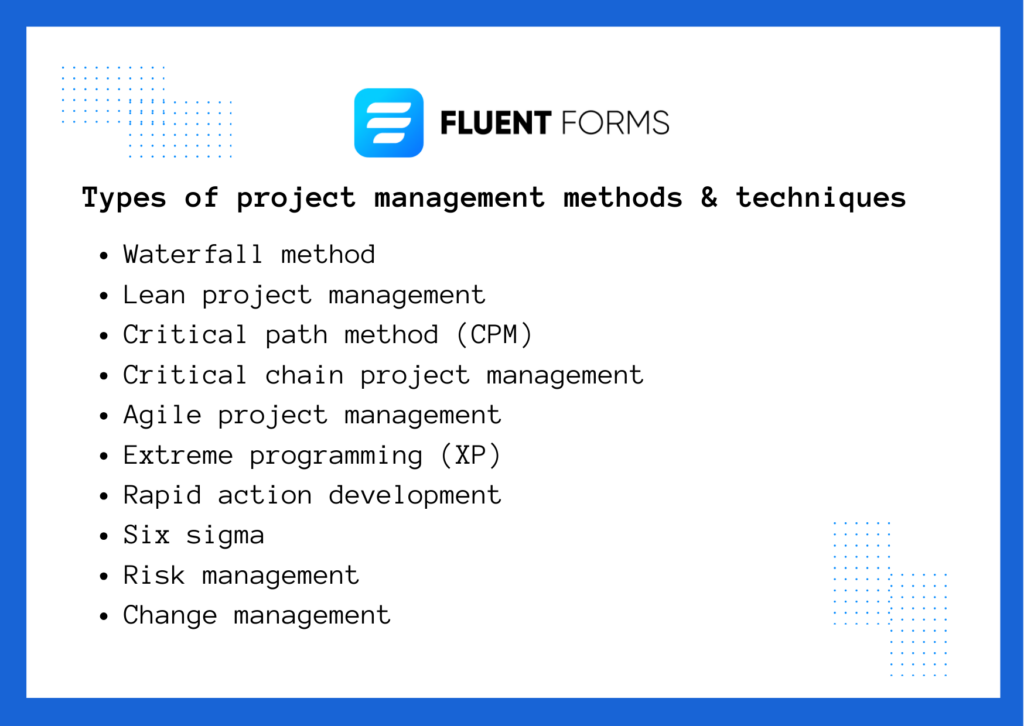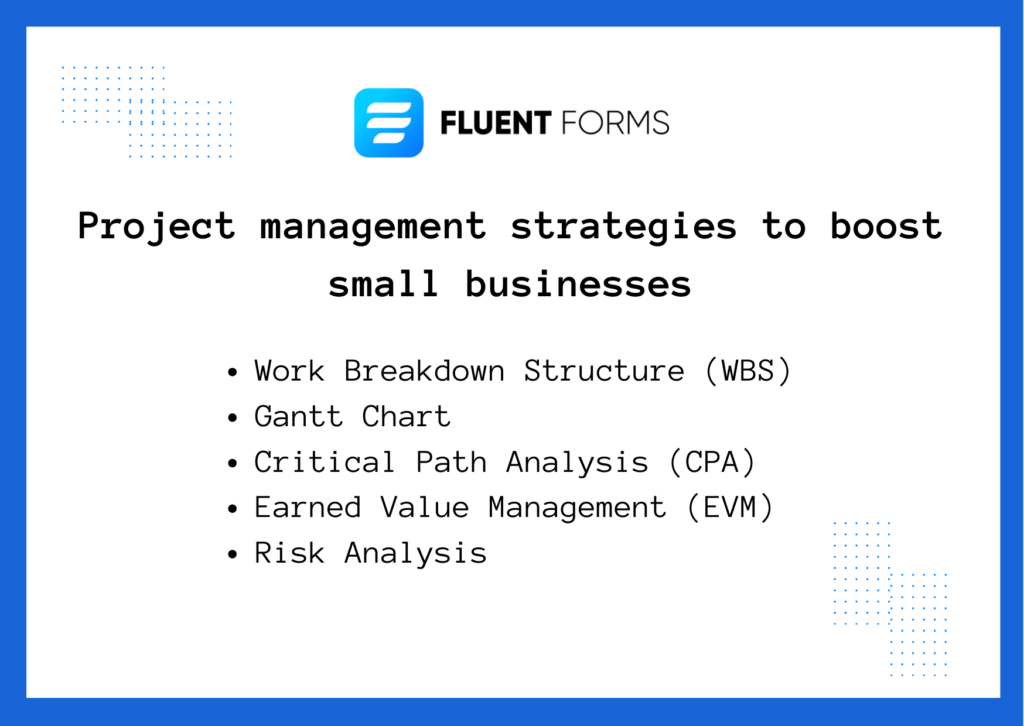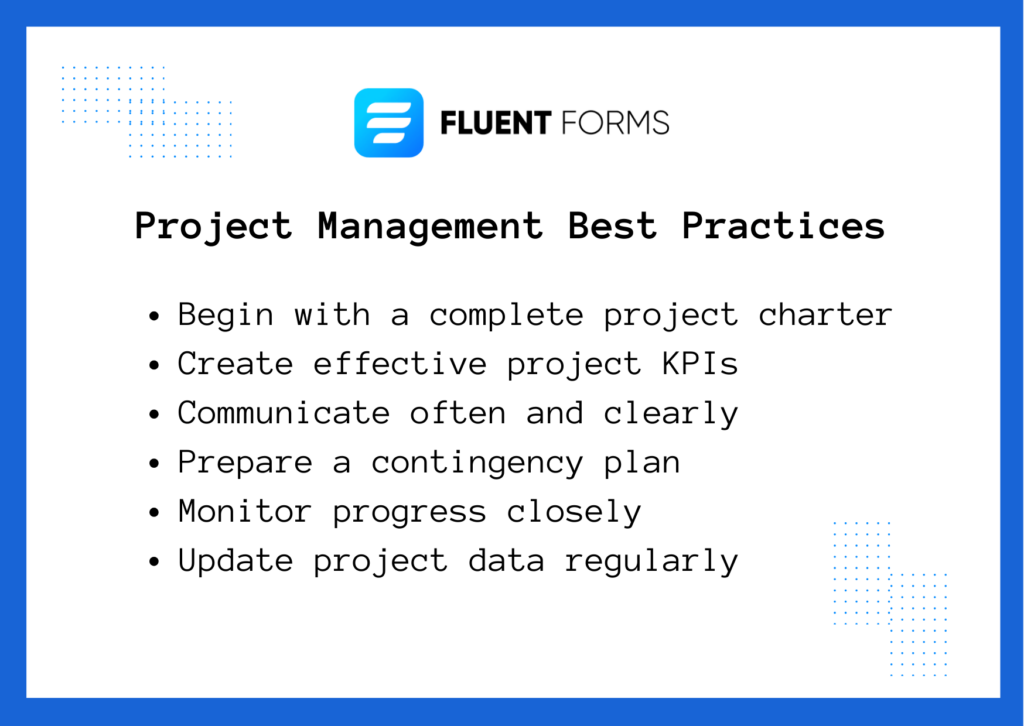Project Management for Small Businesses: Tips & Strategies

Project management for small businesses can be a tricky job since you’re only beginning to grow. Undertaking a new project is always scary. You may or may not have experience in the particular section, but can’t afford to fail. Your resources are limited, and you need to make the most of them. You might also be wondering if your small team is enough to run the course of this project or if they will be burned out.
In this blog, we will help you to understand the need for project management for your small business. Do you need project management strategies to operate or how can you run your projects smoothly? We have everything covered here.
5 ways your small business can benefit from project management
Project management can help both small businesses and big run their tasks efficiently. The main difference is the scale here. Small businesses can find numerous help following project management strategies. Here’s how project management can help you run your small business –
Stay on budget and schedule
The stage that comes before project management is project planning. In that stage, you come up with a budget and timeline, among others, for your project. A good project management strategy helps you stay on track planning-wise.
Better control
When strategically managing your project, you break it into small tasks. And when you focus on one task at a time instead of the whole project, it gives you more control. You have control over the details, and no stone gets left unturned.
Increases the odds of success
When you execute your project in a planned way, you create small, manageable tasks. Otherwise, you’d randomly address different aspects. This organized approach ensures your chances of success. By completing each task successfully, you know you’re one step closer to completing your project.
Establishes accountability
When you assign team members to different tasks, you know who’s responsible for which task. That helps with the completion of each task within time because it gives the assigned members incentive and motivation.
Actionable insights
Insights are a deep understanding of a complicated situation. Actionable insights include knowing how to respond to that understanding. Good project management offers actionable insights because it has a clear structure and the tasks are connected. Therefore, you can easily ask the right questions and find answers as to what you should do.
Now you know why project management can not only help but is invaluable to your projects. So, let’s have an overview of how you should start project management and what tips and strategies to follow as you go.

Project management lifecycle
Every project has more or less the same lifecycle. Therefore, to successfully execute a project, you need to know the stages in this cycle. That way, you will know where you stand in completing your project.
Initiation
Initiation is the first stage of project management. This is where you address the issue that needs to be resolved. Then you decide on objectives, goals, and deliverables. This is also the stage where you cover the high-level scope of your project. Next, you list your resources and budget. Finally, discuss with the stakeholders and project analysts whether the project is feasible.
The project charter is a deliverable for this stage.
Planning
This is the stage that you need to craft most carefully. At this stage, you build a work breakdown structure and develop a detailed project timeline. You also create tasks at this stage and allocate resources to those tasks.
Execution
At this stage, you start moving according to your plan. Form a project team and assign members to different tasks according to their expertise. Give the team the necessary guidelines. Communicate with everyone effectively.
Monitoring
Track the progress of tasks. Measure the quality of deliverables. Evaluate the overall performance of your project and see if the quality is worth the cost. See if your team members are working efficiently. Also, check if your project deviated from its scope. If it has, assess how it affects the final outcome of your project or its goals.
Closing
At this stage, you conduct a final analysis of the project’s success or failure rate and document all reports. Identify sectors where you had room for improvement. Gather unused resources and release them for other projects.

Steps for project management for small businesses
Now that you know the project management lifecycle, let’s see how you should advance into project management step by step.
Identify problems
First, you need to figure out what issues your business is facing. If there is more than one, you need to single out the one that requires immediate attention. Once you identify which issue you want to address, you ask the right questions. Questions that answer the causes of the issue and how you should approach them.
Set clear goals and objectives
After identifying the issue, you decide what you expect from resolving it. That’s where your goals and objectives come in. Goals and objectives are almost the same thing, with one vital difference. A goal is a general direction you’re aiming to move towards through the project. Meanwhile, objectives are more specific, and you can often measure them.
Defining Project Scope
Scopes, in general, are bodies of work to accomplish something. Project scope is the method of achieving the project goals and objectives. Scopes determine whether the goals are achievable or not. That is, whether the project is or is not within scope.
Develop a Project Plan
In this step, you create a work breakdown structure, keeping the scope in mind. You can do that in one of two ways. One is a deliverable-based work breakdown structure, and the other is a phase-based work breakdown structure.
You break your work into small, manageable tasks and create sub-tasks under those. You also allocate the necessary resources to each task and build a system to track task updates. And you need to make sure that none of the tasks conflict with your business, project, or other tasks.
Set a budget
After devising a sound plan, calculate a budget that aligns with the quality you expect. While setting a budget, take into account the resources you already have. Then, measure what else you need to complete each task and subtask. Decide on an estimated amount that best covers those expenses and is well within what you can afford.
Building an Effective Project Team
You need to hand-pick members for your project team. The members have to work effectively and have to be in sync with the timeline. The members also need to have the necessary skill set to complete the project. Besides, they need to think on their feet and be efficient at brainstorming and problem-solving.
Keep Your Team Members on the Same Page
Your team members and stakeholders should all be on the same page about the project. They all need to agree on what to expect, how to achieve what to expect, and be aware of the risk factors. Besides, team members need to have a clear idea of their responsibilities. They also need to know how to cooperate and communicate among themselves and with you effectively.
List tangible ‘deliverables’ that you want to achieve
There should be an outcome from almost all the tasks that take your project one step closer to its goals. Those tiny outcomes are deliverables. Deliverables are mostly visible or trackable. Often, the deliverable from one task is used in the completion of its dependent tasks.
You need to list all the expected deliverables before starting on tasks. Once you start accomplishing them, compare them to the expected deliverables. You should also keep a record of the deliverables you accomplish, so it’s easier to track your progress in the later stages.
Monitor Team Performance & Project Progress
Once the project is set in motion, all you have left to do is monitor its progress and your team’s performance. You need to personally keep tabs on every task. See if they’re being done on time. Check the quality of the deliverables. Check if there are any risks, and brainstorm ways to mitigate those risks.
You should also report to the stakeholders, so they are in the know about the progress and the drawbacks. It’ll help you avoid any impractical expectations from the stakeholders.
Identify specific ways to measure your results
You have to determine KPIs for your project. When determining KPIs, make sure you know their purposes. It’s important that your KPIs are SMART (specific, measurable, attainable, relevant, and time-bound). Make sure the KPIs are agreed upon by all parties involved. Some general KPIs are discussed here.
Timeliness KPIs
- See how many times a task has to be rescheduled or its deadline has to be readjusted
- Keep track of how many times the project deadline has been postponed
- Note down how long a particular task takes to complete. This is important for completing repetitive tasks effectively.
- Check the difference between the estimated time and the actual completion time of a task
- Add up the total amount of time each member has to spare; it’ll help you with proper resource allocation.
- Make sure that none of the members are booked on multiple projects at a time; this can interfere with their effectiveness.
Budget KPIs
- Track the difference between the estimated cost and the actual cost
- Check the time required for the research, planning, and approval stages of the budget formulation.
- Track how many times the budget draft had to be updated before it became final and the changes made in each draft. That way, budget planning will be more effective for your next projects.
- You can use a line-item budget. It’s a method used while creating and monitoring financial expenses.
In this process, items are grouped according to departments or costs to find out which share of the budget is going where. Businesses can track the costs of every section separately to check if they’re staying within or exceeding budget. This process can show a comparison of past, present, and future financial expenses.
Quality KPIs
- To measure the quality of your project, you can track customer satisfaction, loyalty, and complaints.
- The satisfaction of stakeholders and employees is another way of measuring quality. It represents the quality of both the project outcome and the work environment.
- You can measure the quality of your work by the number of errors you make at different stages of a project.
Effectiveness KPIs
- Measure how effective your team is to identify, assess, and manage risks.
- Tracking the number of projects or tasks that got canceled can give you an insight into how effective your projects are.
- Calculate the profit against the cost and the resources you’re investing in a project.
- Check if your team members’ time is being utilized properly.
Besides, there are different niche-specific KPIs, and you should research them as well before diving headfirst into a project.
Evaluate the Project After Completion
This step is an analysis of the entire project. This mostly helps shed light on your overall management and organization; find out areas where you can improve next time. You can compare the end result with the planned result and learn from your performance.

Project management tips for beginners
if you are a beginner, follow these project management tips to stay track on to your projects.
Get to know team members
Getting to know your team members helps you in several ways. For example, it makes communication with them easier. You know their skills; therefore, you can determine what position will be most suitable for them. You also learn what work environment they’re most comfortable in and which hours they prefer. All this information makes your job as a project manager easy and successful.
Envision the end goal
Your end goal should be very clear from the very beginning. It should resolve the particular business issue you want to address. You should also estimate how much profit you’re hoping to make, and it should cover the expenses of your project. It also helps if there are additional benefits besides just solving a particular business issue.
Identify and manage project risks
You and your team must be quick to find risk factors and should be very effective at mitigating them. Risks are not uncommon to appear in a project. However, good problem-solving skills help you bypass them. You can at least make sure that the effects are minimal and do not affect your end result.
Prioritize time management
Time management is essential for project management. If a project is dragged on longer than planned, it takes up more resources, and the cost is higher than the project’s worth. It also delays results, and you don’t achieve your goals by the time you need them. So it is very important to stay on track and complete every task within the schedule.
Focus on successful completion instead of perfection
Your aim should be to achieve the goals you planned to achieve through the project. Sometimes, obsessing over the details of single tasks can stand in the way of that, because it takes up more time, energy, and concentration.
Focusing on perfection tires out your team members too soon into the project, and they can’t keep up the concentration. Therefore, you sometimes have to compromise perfection for the sake of the project’s successful completion.
Maintain a work-life balance
You should keep in mind that you and your team members need to make a work-life balance. With too much work, you’ll all be tired soon, and the project will lose its flow. Besides, the project runs a little fast around the end; to keep up with that, you need to make sure you’re getting enough rest when you can.
Hold regular meetings with team members:
Regular meetings with team members are important for effective collaboration within the team. You also learn about team members this way and, therefore, can show them empathy where necessary. Regular meetings also work as motivation for members because they know they have to report to you and have accountability. So, they finish their tasks on time, and thus the whole project runs at a smoother pace.
Keep track of important details
It might seem to you that details are not important, and only the end result is what matters. But you’d be wrong. Details are crucial to the completion of a project. Therefore, you need to note down every piece of data. Because together, those data amount to something larger, and ignoring them doesn’t give you a full view of your project.
Know your limitations
As a good project manager, you should know what your limitations are. This includes, but is not limited to, knowing how much you can accomplish through a project. What you should focus on and what you should let go of or keep in the to-do list because of resource limitations.
Establishing everything when you’re only starting out is pretty uncommon. It’s your job to detect priorities and start with the issues that are most crucial to your business. This way, you have a running project to address the other issues another time.
Minimise distraction
The tasks of a project should be focused on the project and should take the project towards its goals. Any side tasks can be distracting and ruin the flow of the project. Similarly, no team member should be assigned to multiple projects at a time. It can prove to be distracting for them, which hampers the overall progress of a project.

Types of project management methods & techniques
There are various project management methods and techniques. What you should follow? Let’s take a look.
Waterfall method
Waterfall methodology is an approach to project management that insists on a linear progression from beginning to end. Common stages of this method are requirement, design, implementation, verification or testing, and deployment & maintenance.
In the requirement phase, you get a detailed understanding of the client’s demands. Next, you do thorough research to make the project plan. There’s little to no room left for change after that. One stage starts after the completion of another.
Since almost everything is pre-determined, nothing affects the project’s timeline. On the other hand, clients don’t have much room to request changes once the project is running since the method isn’t accommodating to changes. Therefore, it serves the clients better who know what they want with details from the beginning of a project.
Lean project management
Lean project management is designed to obtain maximum value with minimal waste from a project. It relies on continuous improvement (Kaizen) and uses Kanban boards or real-time dashboards as tools. It’s also agile, so it offers better control and decision-making power. Moreover, it ensures increased customer satisfaction.
Critical path method (CPM)
Critical path method is used to create an accurate project schedule. It allows you to identify tasks that are crucial for project completion. The critical path is the longest sequence of tasks in a project and has the most number of tasks. Once the critical path is found, the other chains of tasks can be arranged accordingly.
The time to finish the critical path is usually the same as the time to finish the project. The tasks on the critical path are called critical activities, and they don’t have much flexibility. Tasks that are not on the critical path usually have a more flexible timeline.
Critical path method is very helpful for allocating resources effectively. Furthermore, it’s best if you want to finish your project within its deadline since it’s designed to accommodate resource leveling and resource smoothing.
Critical chain project management
Critical chain project management is a project management technique to prioritize the successful completion of projects. It focuses on efficient resource utilization. In this process, you develop an ideal project workflow, outlining task dependencies and resource constraints during the planning stage.
Unlike the critical path method, it doesn’t focus on a single sequence of tasks. Its focus is on the resources required to complete a project, and often excess resources are allocated for the project to act as buffers. The project is considered to be moving successfully if those additional resources aren’t needed for its completion.
Agile project management
The agile project management methodology breaks the project down into small pieces, called sprints. It is popular for software development projects. Its main characteristic is that it is iterative, i.e., it can adapt to changes caused by any issue throughout the various stages of the project.
Since the project is broken down into sprints, this methodology helps avoid large-scale changes. And timely changes to small issues help save resources and time in the long run.
The team needs to review and create feedback at the end of each sprint. Therefore, the process depends on constant communication and collaboration. Staying updated on everything makes the time-sensitive changes and edits to the sprints way easier and more effective.
Extreme programming (XP)
Extreme programming (XP) is an agile software development method with strict rules and guiding values. It targets speed and simplicity, with short development cycles and less documentation. Software development is broken down into work sprints, which are reviewed after completion for maximum efficiency.
It’s highly creative, collaborative, and based on iterative planning (adapting to changes at all stages). The methodology is best for small teams since it requires constant communication. However, it isn’t suitable for beginners since members need to work and make changes quickly.
Rapid action development
Rapid action development (RAD) is another example of an agile project management strategy. It is mostly popular in the software development industry. It focuses on minimizing the planning stage and maximizing the prototype development stage. It’s best for projects running at a fast pace.
Since RAD has a task-oriented structure, it lets you break the project down into smaller, more manageable tasks. This also allows you to optimize your team’s efficiency because you can assign tasks according to team member’s skills and specialties.
RAD allows project managers and stakeholders to accurately measure progress and communicate in real-time on emerging issues or changes. It’s also strict about deadlines, so all parties must be on the same page before the project starts.
Six sigma
Six sigma is applied to uncover the root cause of an issue in an organized and structured way, as opposed to finding it through trial and error. It’s an iterative process usually used in the software industry to find and eliminate bugs and defects.
It focuses on deducting costs and minimizing waste. It also identifies and eliminates roadblocks before you hit them. Moreover, it brings higher customer satisfaction since you provide them with products without defects or issues.
However, it’s also a time-consuming, complex, and ongoing process. Sometimes it’s even costly, depending on the number of issues to be resolved.
Risk management
Risk management methodology focuses on any risk factors that might arise during the course of the project. Risks can be both positive and negative, anything that can have an impact on the project’s timeline, budget, resources, objectives, or anything else. While negative risks negatively affect a project, positive risks might present an opportunity.
The steps of the risk management process are identifying the risks, analyzing them, prioritizing risks and issues, responding to them, and monitoring them.
Change management
Change is anything that impacts the original plan of a project. It is a combination of managing change and managing people (teams and stakeholders). The project manager monitors team member’s work to ensure they incorporate change successfully.
Since change might cause disruption, managing it minimizes distractions, increasing focus and efficiency. It also enhances performance and spreads a practice of adaptability among the team members.
You can always choose one of these methods and techniques, or a hybrid of two or more, for project management for small businesses. If you choose a hybrid, all you have to keep in mind is that the methods don’t conflict with each other.

Project management strategies to boost small businesses
To gain a higher success rate from your projects, you need to put some strategies in place. Any strategy that serves you or your small business project best. It can be about data viewing and management, team, time, and resource management, communication, etc. It can also be about your plan, next steps, risk management strategy, or anything else. Some of the popular strategies are discussed here.
Work Breakdown Structure (WBS)
A work breakdown structure is a deliverable-oriented deconstruction of a project. You break the project into small tasks, each of which provides you with a deliverable after completion. Those deliverables show your progress, and you can determine whether and how fast you are moving towards your goals. Its stages are initiation, planning, execution, control, and closeout.
Gantt Chart
Gantt chart is a very popular way of viewing project data. You can easily track what percentage of each task has been done. You can also assign members to the chart and keep track of the resources and costs. There are different project management tools and project management AI tools where your Gantt chart gets updated automatically with the progress of each task.
Critical Path Analysis (CPA)
In critical path analysis, you identify the longest chain of tasks in your project. It has the most number of tasks to be completed sequentially. Therefore, it provides you with a rough estimation of how long your project will take to complete. You can then arrange the tasks that are not critical activities according to your flexibility.
Earned Value Management (EVM)
Earned value management (EVM) is a project management methodology based on the work breakdown structure. It integrates schedule, costs, budget, and scope. Then it uses formulas to measure project performance and progress.
It uses some core elements for these calculations, for example,
Planned Value: It calculates where your project tasks should be at a specific point in the project timeline and the estimated cost up until that point.
Planned Value (PV) = % of project completed (planned) * Project Budget
Actual Cost: calculation of the actual cost of the work that’s been completed over a specific project period
Actual Cost (AC) = Actual costs to date
Earned Value: measures the value of the work that’s been completed up to a certain date in the project
Earned Value = % of completed work * BAC (Budget at Completion)
Using these elements, you can measure various earned values using this process, for instance,
Schedule Variance: measures how far ahead or behind schedule the project is
Schedule Variance (SV) = Earned value (EV) – Planned Value (PV)
Cost Variance: measures the difference between the actual and planned cost at a certain point in a project
Cost Variance (CV) = Earned value (EV) – Actual Cost (AC)
Schedule Performance Index: Calculates the ratio of how much ahead or behind schedule your project is. If the value is less than 1, that means you are behind, and if it is greater than 1, it means you’re ahead.
Schedule Performance Index (SPI) = Earned value (EV) / Planned Value (PV)
Cost Performance Index: measures how efficient costs are in the project. If your result is less than 1, your costs are higher than budgeted. If it’s higher than 1, the costs are less than budgeted.
Cost Performance Index (CPI) = Earned Value (EV) / Actual Cost (AC)
Estimated at Completion: the current expectation of what the total costs will be to complete the project
Estimated at Completion (EAC) = Budget at completion (BAC) / Cost performance index (CPI)
Since it’s mathematical, there’s not much room for error. You can apply it after the completion of various stages of your project. However, it doesn’t work if the data is incorrect. Also, you can’t ensure quality using this strategy.
Risk Analysis
You should always brainstorm all the things that can go wrong while the project is up and running during the planning stage. It may appear pessimistic, but it actually prepares you for what may come or affect your project internally and externally.
For example, you can have a backup vendor and a suitable replacement if one of your team members isn’t available midway through. More importantly, you need a strategy in place if your plan A doesn’t prove as promising.

Project management best practices
You made sure you’re applying all the tips, strategies, and techniques. Still, you’re wondering what else you can do. In that case, you can check out this list of best practices for project management for small businesses.
Begin with a complete project charter
The Project Charter is a document outlining a detailed overview of the project’s goals, scope, and stakeholders. You develop it during the initiation stage of your project. It offers an overall framework and direction for the project workflow.
Communicate often and clearly
Believe it or not, communication is the key to success in this case. Everyone concerned with the project needs to know the necessary information. It’s crucial for the timely and successful delivery of tasks, which is only possible through effective communication.
Prepare a contingency plan
You need to plan your project so carefully that all the loopholes are covered, and it leads you to success smoothly. But even then, you need a contingency plan in place. You never have to need it; you only need to make sure it’s there and it’s good enough to cover all the bases to achieve your original goals and objectives.
You can have a plan B for your entire project as well as the tasks to back you up in case of any emergency. You especially need backup plans for the risky areas of your project.
Monitor progress closely
If you don’t monitor your project closely, you won’t know in time if it’s deviating from the original plans. Mitigation might cost you additional time and resources that you can avoid by conducting close observation at all times.
Update project data regularly
You should update your project data regularly while it’s still fresh. A delayed update might interfere with the accuracy or can keep you from finding out a risk factor in time to revert it.
A regular update is also good for cost and resource management. Furthermore, you can track your team’s effectiveness with a regular update.

Conclusion
Project management for small businesses is never easy. It requires dedication, patience, and perseverance. The tips and strategies are here to aid you, but you have to actually do it and go through all the hardship. Do thorough research about project management in general and sectors specific to your niche before approaching a project. You can also get help from different project management software and tools to help you along the way.
Let us know which project management methodology you find most reliable for your business. And don’t hesitate to ask if you have any questions regarding any aspect of project management for small businesses.








Leave a Reply
You must be logged in to post a comment.